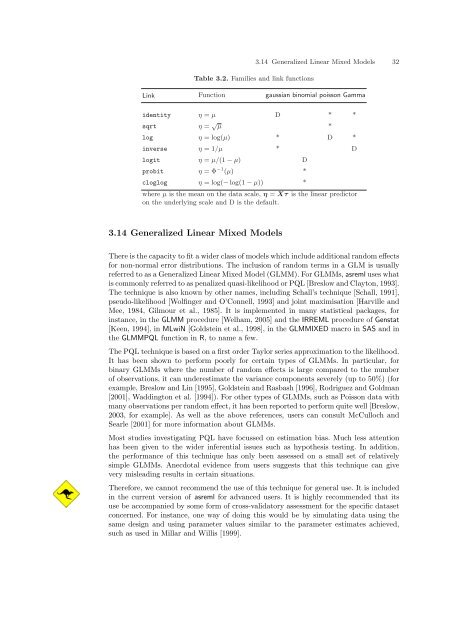ASReml-S reference manual - VSN International
ASReml-S reference manual - VSN International
ASReml-S reference manual - VSN International
- No tags were found...
You also want an ePaper? Increase the reach of your titles
YUMPU automatically turns print PDFs into web optimized ePapers that Google loves.
Table 3.2. Families and link functions3.14 Generalized Linear Mixed Models 32Link Function gaussian binomial poisson Gammaidentity η = µ D * *sqrt η = √ µ *log η = log(µ) * D *inverse η = 1/µ * Dlogit η = µ/(1 − µ) Dprobit η = Φ −1 (µ) *cloglog η = log(− log(1 − µ)) *where µ is the mean on the data scale, η = Xτ is the linear predictoron the underlying scale and D is the default.3.14 Generalized Linear Mixed ModelsThere is the capacity to fit a wider class of models which include additional random effectsfor non-normal error distributions. The inclusion of random terms in a GLM is usuallyreferred to as a Generalized Linear Mixed Model (GLMM). For GLMMs, asreml uses whatis commonly referred to as penalized quasi-likelihood or PQL [Breslow and Clayton, 1993].The technique is also known by other names, including Schall’s technique [Schall, 1991],pseudo-likelihood [Wolfinger and O’Connell, 1993] and joint maximisation [Harville andMee, 1984, Gilmour et al., 1985]. It is implemented in many statistical packages, forinstance, in the GLMM procedure [Welham, 2005] and the IRREML procedure of Genstat[Keen, 1994], in MLwiN [Goldstein et al., 1998], in the GLMMIXED macro in SAS and inthe GLMMPQL function in R, to name a few.The PQL technique is based on a first order Taylor series approximation to the likelihood.It has been shown to perform poorly for certain types of GLMMs. In particular, forbinary GLMMs where the number of random effects is large compared to the numberof observations, it can underestimate the variance components severely (up to 50%) (forexample, Breslow and Lin [1995], Goldstein and Rasbash [1996], Rodriguez and Goldman[2001], Waddington et al. [1994]). For other types of GLMMs, such as Poisson data withmany observations per random effect, it has been reported to perform quite well [Breslow,2003, for example]. As well as the above <strong>reference</strong>s, users can consult McCulloch andSearle [2001] for more information about GLMMs.Most studies investigating PQL have focussed on estimation bias. Much less attentionhas been given to the wider inferential issues such as hypothesis testing. In addition,the performance of this technique has only been assessed on a small set of relativelysimple GLMMs. Anecdotal evidence from users suggests that this technique can givevery misleading results in certain situations.Therefore, we cannot recommend the use of this technique for general use. It is includedin the current version of asreml for advanced users. It is highly recommended that itsuse be accompanied by some form of cross-validatory assessment for the specific datasetconcerned. For instance, one way of doing this would be by simulating data using thesame design and using parameter values similar to the parameter estimates achieved,such as used in Millar and Willis [1999].
















